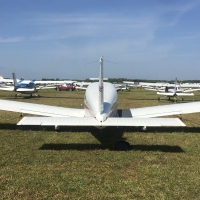Is there a CG sweet spot?
I've heard of Cherokee folks putting some "extra" weight in the luggage area to help with a "nose heavy" situation, perhaps when flying alone or no rear seat passengers. Some suggest that this helps create a more efficient flying configuration, negating the need for excess up trim.
So I'm wondering if there is a "CG sweet spot" that would help establish a more efficient flying configuration?
Although adding extra weight seems counter-productive to me...
Thx, Bill
'73 PA28-180 Challenger


Comments
Odd you should bring this up.
One of the dispatchers just retired from NetJets and he needed to go from Columbus, Ohio to KBGF Winchester TN and back in a day so I offered my plane. I keep about 20 pounds of stuff in the baggage but my CFI friend who flew him down said my Arrow was nose heavy and had significant deflection of the tail at the beginning of the flight. As fuel burned off the plane sped up and felt about right.
A few days after he took Wild Bill to TN, Ed my CFI friend, my daughter and I along with all the beauty supplies needed by a teenage girl loaded in my Arrow and went to Sun N Fun. Even at max gross Ed said the plane handled better than with him at 180, Wild Bill at 340 and 20 pounds of oil, glass cleaner and rags in the back.
He was in CG but more forward than I have seen before with just Bill. Ed said he could not believe the difference in handling loaded with all our stuff for more weight vs just Bill and the far forward CG. If he flys Bill again he is adding weight to the back.
1973 Arrow II factory AC removed
G5’S, G275, GNX375 Still can get lost.
From what I have seen, and experienced, adding weight depends on the frame and engine.
In the normally aspirated 4 cylinder PA-28's with a normal tail (both Hershey and tapered wing), did not really notice differences in speed based on placement of weight. I did pay attention to rear weight for cross countries which pushed the fuel tank limits as my math showed that low fuel and just me moved CG to the envelope's forward edge (not where I wanted it).
PA-32 is a different beast. The 6 cylinder way out front makes a tendency for CG sitting forward in the envelope. By adding weight to the rear cargo, goal is moving CG to the envelope's middle section. Getting CG to the envelope's rear section is a challenge (and not where I want it anyway). Am in the crowd of starting with 50 pounds in rear storage. Recently saw where a turbo PA-32 found it difficult to climb past FL180 (that specific plane's service ceiling is 20K' and the owner simply wanted to go there) where in chat it was revealed there was zero weight in the rear and the calculated CG was in the envelope's forward range.
So, back to the effects. Yes, there is more than some Internet lore type suggestion that CG location effects configuration (speed and handling), it is real. When the CG is forward, this causes the stabilator to work by pushing the tail down, result is that parasitic drag happens and reduces speed. When CG is in the envelope's middle section, gravity helps keep the tail down, which does not force the stabilator to work as much, and result is less parasitic drag.
End result is that while each plane is unique, in general it should cruise best with CG in the envelope's middle to slightly aft section. Even if this means adding dead weight to the rear.
I noticed that the PA28-180 seemed easier to land (soft vs not so soft touchdown) with luggage or back seat PAX that shifts the CG aft. But more weight requires more power to maintain level cruise flight at a given speed. No free lunch.
The more the thought of no free lunch rattles around in my head, the more it does actually look like a free lunch. Especially for longer flights.
In terms of effects, while additional dead weight increases fuel consumption by way of moving that weight to altitude, and the wings' additional lift necessary to suspend that weight, the real killer of fuel economy is parasitic drag from the stabilator. By moving CG to a desirable location, it lowers parasitic drag as now the stabilator does not have to create as much of its own (downward facing) lift to compensate for a CG forward in the envelope.
For the PA-28 crowd, it is just a matter of reallocating existing weight to gain some cruise speed, so definitely a net positive here. Even moving luggage into rear storage instead of rear seats counts.
For the PA-32 crowd, granted we are looking at adding some dead weight in rear storage which will certainly eat more fuel on initial climb. This is basic physics. When comparing 50 pounds against useful load, it is a tiny fraction and am not sure it shows up as a noticeable difference on the takeoff climb sequence. Given the effects of this dead weight during cruise climb and cruise, it is tough to see a downside as speed increases for the same power setting as when without the counterweight. Put another way, the plane will get there quicker resulting in lower fuel consumption for the same distance. Also, the only time to add extra weight is when not carrying any luggage or passengers to assist with moving CG rearward. If there are passengers and luggage, move stuff around for a desirable CG and leave some, or all, of the extra weight at home. So, again, another round of net positives.